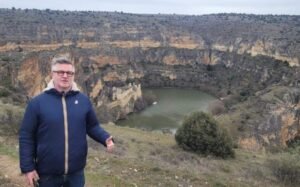Luigi Colani Rebel with Polish roots who changed the world of design

Luigi Colani is one of the greatest design visionaries of the 20th and 21st centuries. For decades, he created objects that shocked and delighted with forms, but above all introduced innovative solutions.
Unique, biomorphic forms, inspired by nature, were ahead of their time, and he himself consistently followed his own path, ignoring the established schemes and conventional approaches to design. His design philosophy – biodesign – drew heavily on the natural world.
The MARTa Museum of art, design and architecture in Herford, Germany, gives you a chance to gain a deeper understanding of Luigi Colani’s creative method and the importance of his work for contemporary design. For design fans, the exhibition “Luigi Colani – forms of the future” is an extraordinary opportunity to see what life would look like if his visions were fully realized.
Philosopher 3D: technology and art
Luigi Colani was born in Berlin in 1928, the son of a Polish woman and a Swiss Kurd. He recalled that from childhood he was fascinated by both art and engineering, which he later studied: sculpture, painting, as well as industrial design and aerodynamics, which allowed him to combine creativity with a scientific approach to form and function.
“I consider myself a 3D philosopher. I’m not a designer at all. I studied aerodynamics, philosophy and sculpture. On the one hand, it is advanced technology, and on the other – art,” he said in an interview (2009, The Interview Magazine).
An important factor in his development as a designer in his youth was living near the airport and watching airplanes, but also trips with his father to the racetrack, where speed tests of cars were held. Over time, Colani developed his design philosophy, becoming a pioneer of biodynamics in design. It was based on observing nature and drawing inspiration from organic shapes and the way animals and plants adapt to their surroundings. His designs were often based on natural shapes such as insect shells, fish fins and mollusc shells, which he believed offered the most effective solutions for ergonomics and aerodynamics.
In the same interview he pointed out: “look at nature – the birds, the fish. Things that look good also work well. People don’t understand the message of ergonomics.”
“I follow Galileo.”
One of the most fascinating aspects of Colani’s work was its versatility and its supranational nature, as he worked all over the world. He has worked with many international corporations, including Canon, Sony and Rosenthal. His innovative approach to design was often perceived as controversial, but it never went unnoticed. Colani considered the classical design, geometric and constructed of intersecting straight lines, to be outdated and unfriendly. As a rebel, indifferent to criticism and statements that “it is impossible and does not do”, he designed extremely liquid and organic forms.
In a 2016 interview with The Guardian, he said: “the Earth is round, all celestial bodies are round; they all move in circular or elliptical orbits. The same image of circular globe-shaped mini-worlds orbiting each other follows us all the way to the microcosm. We are even excited by the round forms in eroticism associated with the reproduction of species. Why would I join a wandering mass that wants to make everything angular? I’m going to follow Galileo’s philosophy: my world is round too.”
Impact on the automotive industry
In the 1950s. he began working as a designer in the automotive industry, collaborating m.in. Fiat, BMW and Alfa Romeo. His car concepts were revolutionary-aerodynamic, streamlined and ergonomically designed. They shocked with bold forms, resembling space vehicles.
Colani was also involved in the design of green transport solutions. In his concepts of electric cars, aerodynamic trains and modern floating craft, he envisioned a future in which mobility would become more environmentally friendly.
In the 1970s. he designed one of the most famous concept vehicles – the Colani Truck, whose aerodynamic shape was designed to minimize fuel consumption. His car designs were not only visually impressive, but also functional, which was later reflected in modern solutions used in the automotive industry.
The legacy that changed design
He designed not only cars, but also airplanes, trains, motorcycles, yachts, and even furniture, electronic equipment and clothing (including uniforms for the Hamburg police). Its characteristic, cloudy forms can be seen both in futuristic vehicle concepts, and in ergonomic pens or computer keyboards, and even in cups and pint glasses, washbasins and seats, and even… an educational capsule that replaces the study room.
However, there is an area with which he wanted nothing to do: the arms industry. He said: “I am a very calm person. In the 1980s. I was the chief designer at Thyssen, one of the biggest companies in Germany. But when they asked me to design armored vehicles, tanks and submarines, I gave up overnight.”
In an era in which sustainability and an ecological approach to design are becoming increasingly important, Colani’s ideas seem more relevant than ever before. Its influence is visible not only in the automotive world, but also in the design of electronic equipment, architecture and everyday objects. Modern design increasingly turns to biomorphic forms and advanced materials, which was one of the main tenets of Colani’s philosophy.
He once explained, “I’ve learned to ask myself questions like: Why is something done this way and not that way? Why does the car look the way it does? Is that good or bad? What is an airplane? Why does it have such a shape? Later I became a diver and studied underwater life and the fluidity of sharks and manta rays. Every fish is better than the shapes we humans have invented. And unchanged for 250 million years!”
Luigi Colani died in 2019, leaving behind a huge legacy that still inspires young designers and engineers. His work can be found in museums around the world, and his concepts, although not always implemented on a large scale, have had a significant impact on the development of design in many industries.
Exhibition “Luigi Colani-forms of the future”
“It’s fascinating how much one man can design in his lifetime. The choice is extremely large. Thanks to the objects shown, viewers can make a small journey, get to know Colani as a person. The exhibition offers an overview, from a pen to a luxury car. It was crazy for us when we saw what areas of design he enters with his projects” – they say in the video accompanying the exhibition “Luigi Colani-forms of the future”, its curators, also designers Julian Puszt and Tobias Henschen.
For lovers of design and futuristic visions, the MARTa Museum in Herford offers a unique opportunity to explore Colani’s work. The exhibition, open until March 23, 2025, offers an extensive overview of his most significant projects, as well as rarely presented prototypes and concept sketches. The exhibition shows not only the artist’s work, but also his influence on contemporary design and future technologies.
The “Bring Your Own Colani” section is an interactive, “growing” part of the exhibition that focuses on the designer’s reach in everyday life. Visitors are encouraged to bring their own objects, designed by Luigi Colani and present their history. They will be displayed on the shelves and will change during the exhibition.
I can’t think of a better place for this exhibition. The MARTa museum is one of the most unusual museum buildings in the world. The American architect Frank Gehry – one of the main representatives of deconstructionism and winner of the Pritzker Prize-designed the liquid form like Colani’s designs. “As moving spatial solids with almost dance-like choreography, this architecture transforms every exhibition into a unique spatial experience.”







